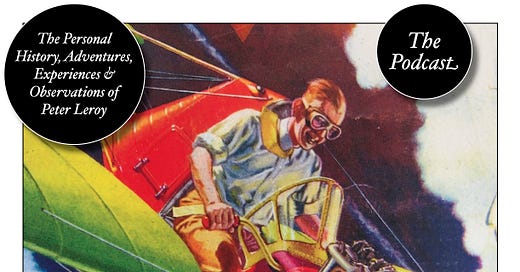WHEN I GOT HOME from Marvin’s, my father was out on the patio, cooking a chuck steak.
For my father the barbecue season never stopped. There was a period, from November through February, I guess, when conditions kept him from grilling as much as he might have wanted to and when snow sometimes kept him from even reaching the grill, but these were only interruptions of his barbecuing, gaps within a circular season, not the ends of it, so it could never accurately be said of him that he had stopped barbecuing. Does that mean that the barbecue season in Babbington as a whole never stopped? I suppose that for people of a certain elevated social class the season never began—but I’m not at all certain that that could be the case, since it seems to me that on any fine weekend night in the summer the air of Babbington was rich with the odor of burning beef, and if even one griller was at it year round—and my father was that griller—then wouldn’t we have to say that the activity itself had no term, that it was a cycle falling from more to less, rising from less to more, seamlessly, endlessly?
My father prided himself on his talent as a barbecue cook. He had built a patio as his outdoor kitchen. It filled the “el” at the back of our house, the space between the projecting dining room and what we called my mother’s little room. When our house was originally constructed, its plan was a simple rectangle, but additions had made it more complicated. My father had added a dining room first, straight out the back from the kitchen, and then he had extended the opposite end by adding my mother’s little room, which I was told to refer to as a bedroom, though it had no bed and no one slept there. In this room my mother tried for several years to run small businesses of her own, one after another, illegally, I think, since the neighborhood wasn’t zoned for that sort of thing. At various times she tried to sell lamps made from bottles encrusted with seashells, chenille automobile seat covers for hot summers, handmade crewel place mats stitched up to resemble photographs of a customer’s loved ones, and, as I’ve mentioned, bamboo fishing poles. The most successful of her businesses, Ella’s Lunch Launch, came later—and that is another story. The business that led to the building of her little room was Fudge in a Bunch, fudge molded into the shape of bananas and wrapped in yellow paper that one could peel back bite by bite. My mother launched into the Fudge in a Bunch business with an enthusiasm that completely possessed her. We saw the same captivating enthusiasm at the start of all her other ventures. Each time, she made elaborate plans, designed ads, and made a stab at running whatever business it was, but after a while, when she found it harder and less interesting than she had expected, she began losing interest, the business petered out, its equipment traveled to the cellar, and a new enthusiasm replaced it. It wasn’t always easy to tell where one of these enthusiasms stopped and the next began. Each of her businesses left its souvenir. The fishing rods gave us the grove of bamboo, and the fudge bananas gave us my mother’s little room. The kitchen became the fudge factory, we wrapped the bananas and assembled the bunches in the dining room, and my father and some friends of his built the little room to serve as the warehouse and executive office suite.
The dining room and my mother’s little room altered the shape of the house so that in the back there was a notch where one wall of the dining room met the longer wall of the original house, extended by a wall of my mother’s little room. The patio where my father did his barbecuing filled this el. (A nook such as this was always known as “the el” in my neighborhood. I assumed that the name referred to the letter, but research suggests to me that it is derived by extension from an ancient term, ell in British English, a shortening of Middle English ele, meaning “transept” or “wing,” related to aisle.)
Most of the homeowners on our block had built patios. Magazines were full of plans for them. In those days people did not have decks. Concrete was the favored patio material in my neighborhood. To build a patio, the home handyman began with some boards nailed together to make molds. The concrete mixture was poured into these molds and allowed to harden, and then the resulting blocks were fitted together on a bed of sand to make the patio. Squares, diamonds, and hexagons were the usual shapes for the blocks, but the man who lived next door apparently found regular polygons dull. He built his patio of unique, oddly shaped blocks, each one molded in place, its shape decided only after a long period of beery meditation. The patio took him months to build, but it must have been worth it, because he was thereafter held in high regard as a screwball genius, with depths of personality unimagined before he built his odd patio. My father took a straightforward approach: he built our patio of squares. With such an outstanding example next door, I found this embarrassing.
[to be continued]
Have you missed an episode or two or several?
You can begin reading at the beginning or you can catch up by visiting the archive or consulting the index to the Topical Guide. The Substack serialization of Little Follies begins here; Herb ’n’ Lorna begins here; Reservations Recommended begins here; Where Do You Stop? begins here.
You can listen to the episodes on the Personal History podcast. Begin at the beginning or scroll through the episodes to find what you’ve missed. The Substack podcast reading of Little Follies begins here; Herb ’n’ Lorna begins here; Reservations Recommended begins here; Where Do You Stop? begins here.
You can listen to “My Mother Takes a Tumble” and “Do Clams Bite?” complete and uninterrupted as audiobooks through YouTube.
You can ensure that you never miss a future issue by getting a free subscription. (You can help support the work by choosing a paid subscription instead.)
At Apple Books you can download free eBooks of Little Follies, Herb ’n’ Lorna, and Reservations Recommended.
You’ll find overviews of the entire work in An Introduction to The Personal History, Adventures, Experiences & Observations of Peter Leroy (a pdf document) and at Encyclopedia.com.














Share this post